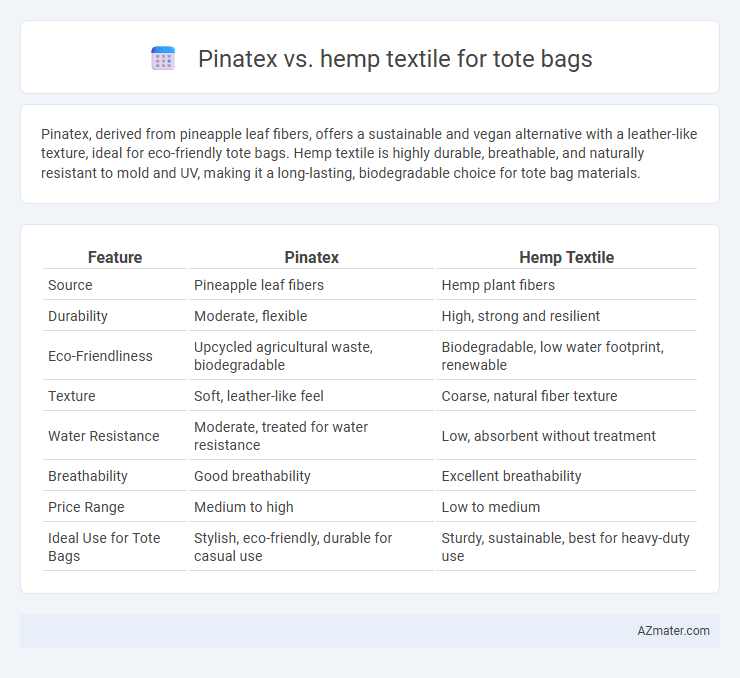Pinatex, derived from pineapple leaf fibers, offers a sustainable and vegan alternative with a leather-like texture, ideal for eco-friendly tote bags. Hemp textile is highly durable, breathable, and naturally resistant to mold and UV, making it a long-lasting, biodegradable choice for tote bag materials.
Table of Comparison
| Feature | Pinatex | Hemp Textile |
|---|---|---|
| Source | Pineapple leaf fibers | Hemp plant fibers |
| Durability | Moderate, flexible | High, strong and resilient |
| Eco-Friendliness | Upcycled agricultural waste, biodegradable | Biodegradable, low water footprint, renewable |
| Texture | Soft, leather-like feel | Coarse, natural fiber texture |
| Water Resistance | Moderate, treated for water resistance | Low, absorbent without treatment |
| Breathability | Good breathability | Excellent breathability |
| Price Range | Medium to high | Low to medium |
| Ideal Use for Tote Bags | Stylish, eco-friendly, durable for casual use | Sturdy, sustainable, best for heavy-duty use |
Introduction to Piñatex and Hemp Textiles
Pinatex is an innovative, sustainable textile made from pineapple leaf fibers, valued for its eco-friendly production and leather-like durability, ideal for tote bags. Hemp textiles, derived from the fibers of the hemp plant, offer strong, breathable, and naturally resistant material, making them a popular choice for durable and biodegradable bags. Both Pinatex and hemp provide environmentally conscious alternatives to traditional leather and synthetic fabrics in tote bag manufacturing.
Sustainability Comparison: Piñatex vs Hemp
Pinatex, made from pineapple leaf fibers, utilizes agricultural waste, reducing landfill impact and water consumption, making it a highly sustainable alternative to traditional textiles. Hemp textile is renowned for its rapid growth, low pesticide requirement, and ability to improve soil health, offering exceptional environmental benefits and carbon sequestration properties. Both materials provide eco-friendly options for tote bags, but Pinatex excels in waste valorization while hemp delivers superior biodegradability and durability for long-term use.
Material Source and Extraction Processes
Pinatex is derived from pineapple leaf fibers, a byproduct of the agricultural industry, utilizing a sustainable extraction process that involves decortication and mechanical fiber extraction without chemicals. Hemp textile originates from the stalks of the hemp plant, where the fibers are separated through retting--either water, dew, or enzymatic methods--followed by decortication and combing to produce strong, durable material. Both Pinatex and hemp offer eco-friendly alternatives for tote bags, with Pinatex emphasizing upcycling agricultural waste and hemp providing a fast-growing, low-impact crop with minimal chemical inputs.
Environmental Impact of Production
Pinatex production utilizes pineapple leaf fibers, an agricultural byproduct, significantly reducing waste and minimizing water consumption compared to traditional textiles. Hemp textile cultivation requires less pesticide and fertilizer, boasting a fast growth cycle that enhances soil health and carbon sequestration. Both materials offer sustainable alternatives to conventional cotton and synthetic fabrics, with Pinatex excelling in waste reduction and hemp providing robust environmental benefits through regenerative farming.
Durability and Strength for Tote Bags
Pinatex, derived from pineapple leaf fibers, offers moderate durability with a unique texture ideal for lightweight tote bags but may show wear faster under heavy loads. Hemp textile is renowned for its exceptional strength and long-lasting durability, making it highly suitable for heavy-duty tote bags that require resistance to stretching and tearing. For tote bags demanding robust performance, hemp provides superior tensile strength and abrasion resistance compared to Pinatex.
Aesthetic Appeal and Design Flexibility
Pinatex offers a unique, natural texture derived from pineapple leaf fibers, providing a rustic, eco-friendly aesthetic that appeals to sustainable fashion enthusiasts. Hemp textile boasts a durable, smooth finish with excellent dye absorption, allowing for vibrant color options and detailed prints that enhance design versatility. Both materials support innovative tote bag designs, but Pinatex emphasizes organic patterns while hemp excels in customization and longevity.
Comfort and Practicality in Everyday Use
Pinatex offers superior softness and breathability compared to hemp textile, making it more comfortable for long-term carry in tote bags. Hemp textile is highly durable and resistant to wear, providing practical strength and longevity for daily use. Both materials are eco-friendly alternatives to traditional textiles, but Pinatex excels in comfort, while hemp stands out for rugged practicality.
Cost Analysis: Piñatex vs Hemp Tote Bags
Pinatex tote bags generally have a higher production cost due to sourcing pineapple leaf fibers and a more complex manufacturing process compared to hemp, which benefits from established agricultural and processing infrastructures. Hemp tote bags typically offer a more cost-effective option with lower raw material and processing expenses, making them appealing for budget-conscious consumers and large-scale production. Price differences also reflect varying durability and texture preferences, with Pinatex positioned as a premium sustainable alternative.
Consumer Preferences and Market Trends
Pinatex, derived from pineapple leaf fibers, attracts eco-conscious consumers valuing sustainability and animal-free alternatives, while hemp textiles appeal with their natural durability and biodegradability. Market trends indicate increasing demand for plant-based, zero-waste materials in tote bags, with Pinatex gaining popularity in fashion-forward segments and hemp favored for its robustness and longevity. Consumer preferences shift towards transparency and ethical production, driving brands to highlight the environmental benefits and lifecycle impacts of these innovative textiles.
Conclusion: Choosing the Best Textile for Tote Bags
Pinatex offers an innovative, sustainable alternative made from pineapple leaf fibers with a leather-like texture ideal for eco-conscious brands prioritizing biodegradable materials. Hemp textile provides exceptional durability, breathability, and natural resistance to wear, making it highly suitable for heavy-use tote bags requiring longevity. Selecting between Pinatex and hemp depends on balancing environmental impact with functional performance and desired aesthetic for tote bag production.

Infographic: Piñatex vs Hemp textile for Tote bag
 azmater.com
azmater.com